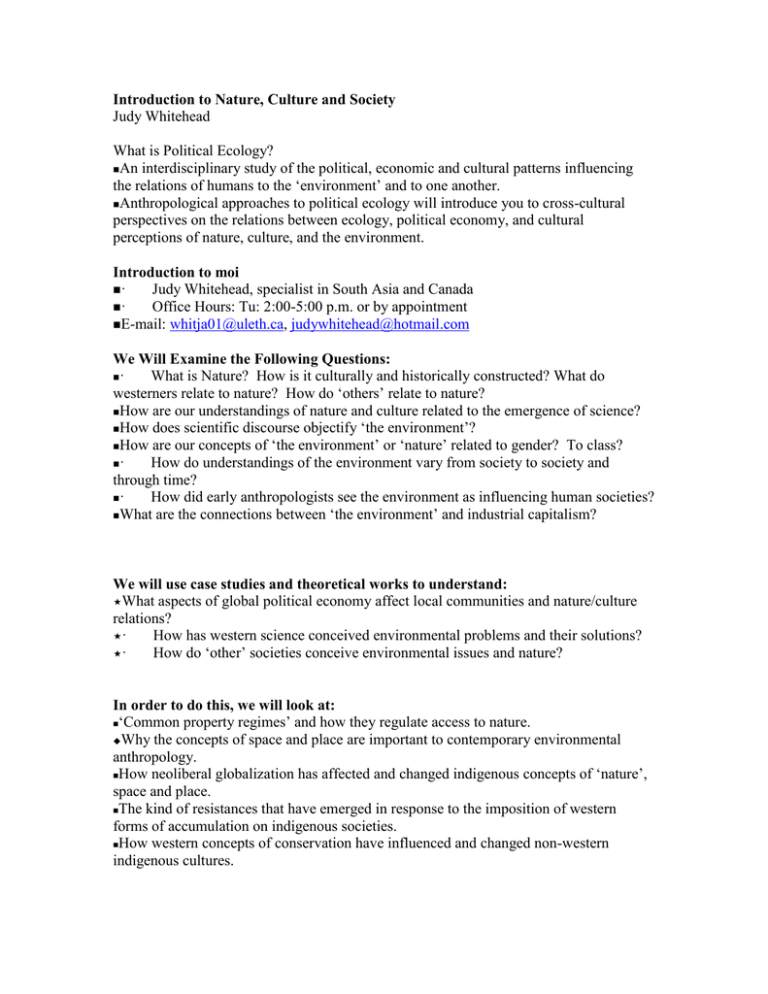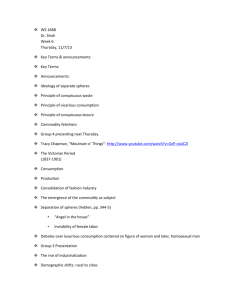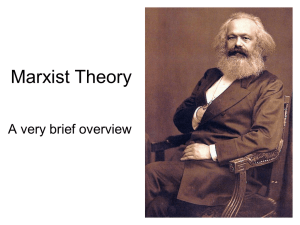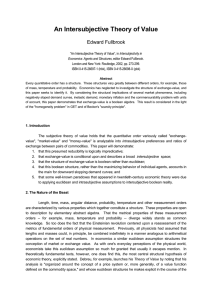Introduction to Nature, Culture and Society Judy Whitehead
advertisement

Introduction to Nature, Culture and Society Judy Whitehead What is Political Ecology? An interdisciplinary study of the political, economic and cultural patterns influencing the relations of humans to the ‘environment’ and to one another. Anthropological approaches to political ecology will introduce you to cross-cultural perspectives on the relations between ecology, political economy, and cultural perceptions of nature, culture, and the environment. Introduction to moi · Judy Whitehead, specialist in South Asia and Canada · Office Hours: Tu: 2:00-5:00 p.m. or by appointment E-mail: whitja01@uleth.ca, judywhitehead@hotmail.com We Will Examine the Following Questions: · What is Nature? How is it culturally and historically constructed? What do westerners relate to nature? How do ‘others’ relate to nature? How are our understandings of nature and culture related to the emergence of science? How does scientific discourse objectify ‘the environment’? How are our concepts of ‘the environment’ or ‘nature’ related to gender? To class? · How do understandings of the environment vary from society to society and through time? · How did early anthropologists see the environment as influencing human societies? What are the connections between ‘the environment’ and industrial capitalism? We will use case studies and theoretical works to understand: What aspects of global political economy affect local communities and nature/culture relations? · How has western science conceived environmental problems and their solutions? · How do ‘other’ societies conceive environmental issues and nature? In order to do this, we will look at: ‘Common property regimes’ and how they regulate access to nature. Why the concepts of space and place are important to contemporary environmental anthropology. How neoliberal globalization has affected and changed indigenous concepts of ‘nature’, space and place. The kind of resistances that have emerged in response to the imposition of western forms of accumulation on indigenous societies. How western concepts of conservation have influenced and changed non-western indigenous cultures. Finally….. We will examine how the privatization of life forms is influencing our concepts of nature and culture, e.g. the human genome project We will also examine how the new biotechnologies and intellectual property laws are changing our notions of ‘society’ and ‘nature’. Assignments: 4 Thought Papers: 40% Questions for Discussion Groups: 10% Annotated Bibliography and Abstract: 15% Final Research Paper: 30% Attendance and Participation: 5% Also: WebCT home page Perspectives of the Course: Anthropology, as a cross-cultural discipline, can show not only how ‘other’ people view and relate to the environment, but also how we do. North America, and Canada, are societies that have been dominated by industrial capitalism that have specific kinds of social relations, institutions and patterns of ‘use’ of the environment. Therefore, it is important to know and understand specific features of this relationship. This relationship is dominated by the imperatives of commodities, commodity fetishism, and the profit-motive. the accumulation of wealth in the form of capital the supreme goal of society. This is not a conscious, but an unconscious motivation, driven by the social relations of the economy and markets in which people lose control over their larger economic decisions. The Market and Commodity Fetishism Market exchange produces the following social constructions: Relations between producers are established indirectly, through relations of monetary exchange. Existence of money in some form as a materialized expression of ‘exchange-value.’ The existence of markets, i.e. innumerable relations between buyers and sellers that determine the relation between supply and demand, and through this, determines those enterprises and activities that can continue, because they are profitable, and those, which cannot because they are not profitable. This structure also produces a drive towards ever-increasing accumulation. Markets and Commodity Fetishism: Definition of commodity fetishism: production and other relations between people take on the form of quantitative relations between things, while things become personified, e.g productivity is associated with capital, not with social relations of work, value becomes linked to money, the stock market becomes an ‘actor’, etc. Example of Columbian peasants working in plantations: reverse our logic of use-value and exchange-value. By definition, therefore, there cannot be an adequate and especially not an oversupply of goods on the market, because the competition between buyers and sellers will work, ‘like an invisible hidden hand’ to provide a balance between the supply of goods and the demand for them. If there is an oversupply of wheat, for example, then competition between sellers will drive the price down until all commodities of wheat will have been sold. If there is an undersupply, then the competition between buyers will drive the price up to the point of profitability at which new producers will enter the market for that commodity (John Bellamy Foster). The Market and the Environment Radical break with all previous human history necessitated by the reduction of human relations to nature to a set of market-based utilities, rooted in the egoistic preferences of individuals. ‘For the first time, nature becomes purely an object for humankind, purely a matter of utility; ceases to be recognized as a power for itself; and the discovery of its autonomous laws appears merely as a ruse so as to subject it to human needs, whether as a means of production (agriculture) or object of consumption.’ This represents the alienation of nature from society in order to develop a one-sided relation to the world. Displacement of the idea of value or worth that results from the domination of market values. Kant: distinction between relative worth or price associated with human inclinations and value as instrinsic worth or dignity, applied to that which constitutes a condition under which something can be an end in itself. 3rd contradiction can be seen in the material consequences. The solution of including the market within the logic of supply and demand may attenuate such problems in the short term, but increase them in the long term, due to the relatively short term laws of accumulation which are intrinsic to capitalism. If more and more of nature is reduced to a cash nexus and is not treated in accordance with broader ecological principles, then the short-term logic of accumulation will predominate. In terms of preserving biodiversity, a market is an extremely inefficient way of doing so in comparison to nature itself. Commodity Fetishism of ‘Landscape’ ……’What we call land is an element of nature inexplicably interwoven with humanity’s institutions. To isolate it and form a market out of it was perhaps the weirdest of all undertakings of our ancestors…The economic function is but one of many…. It invests man’s life with stability; it is the site of his habitation;’ it is a condition of his physical safety; it is the landscape and the seasons. We might as well imagine him and her being born without hands and feed as carrying on his life without land. And yet to separate land from man and organize society in such a way as to satisfy the requirements of a real estate market was a vital part of the concept of creating a market economy’….. Karl Polanyi, ‘The Great Transformation’ Markets, and Environmental ‘Externalities’ Anything that is not bought and sold, does not pass through the market, is external to that system, and is not measured by economics. This includes the activities of child-rearing, recycling, the ‘work’ of the environment to replenish itself, the growing time of crops, subsistence production worldwide, etc. Long-Term and Short-Term Reproduction (of Society and Nature) Capital requires the fastest returns on its investments, often demanding that its initial investment is recouped in a year or two. This means that it becomes oriented to short-term reproduction. However, environmental sustainability is defined in terms of reproducing environmental conditions over generations. Hence, it is oriented towards longer-term sustainability. This is a contradiction: i.e. two aims that are not in conjunction and are difficult to reconcile. Example of global warming and resolutions over changing its increase and effects.





